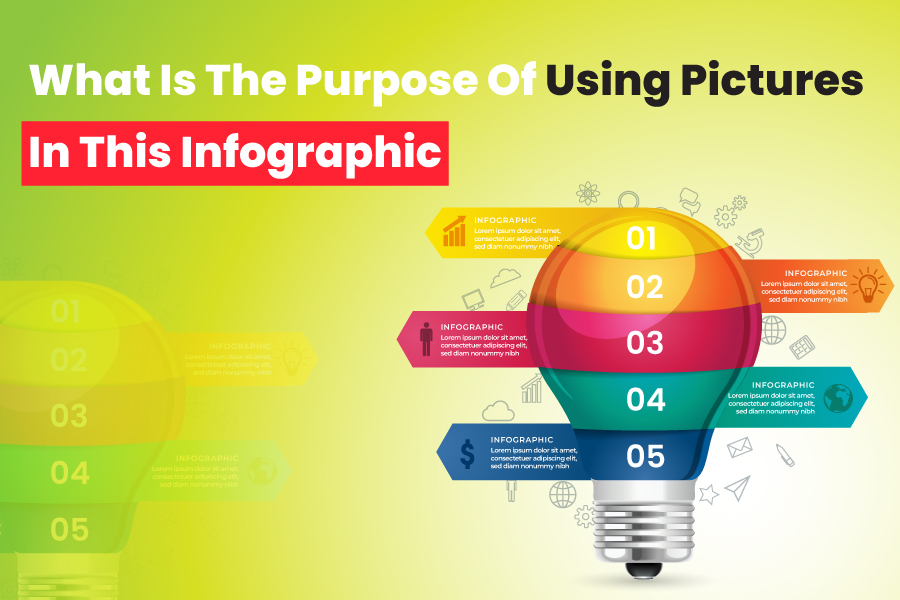Suppose a client asks you, “What is the purpose of using pictures in this infographic?” How would you respond to that? Infographics are powerful visual materials used to simplify complex information. You can use them to convey any type of information, whether data or text. They make complex information easier for people to digest. Most graphics design agencies, such as Designyep, creatively add pictures to infographics. But do pictures have any importance in infographics? Here is what you need to know.
What Is The Purpose of Using Pictures In This Infographics?
The purpose of using pictures in infographics is to sustain visitors’ interest. Humans are virtual creatures and can easily be distracted. With pictures, you can keep your audience hooked on your infographics. Using pictures in infographics will also enable your audience to create a more relatable photographic image of your infographics. It will also cause them to retain much of the information provided in the infographics. Using pictures in your infographics can benefit your campaign in so many ways. It can increase engagement and set your infographics apart.
What Does Infographic Mean
The infographic includes a compelling blend of minimalist text and visual data. It is visual material designed to convey information clearer, more engaging, and simpler. An infographic is a storytelling tool. It makes it easier for people to understand complicated information by turning it into a story. So, the purpose or aim of infographics is to make complex data or information a breeze for people to understand. When used, even nonprofessionals can comprehend complex information and data.
How Can Infographics Benefit Your Online Business?
Infographics aren’t only useful for making complex data simpler. They are useful marketing tools to capture attention and create massive brand awareness. The major target of every marketer or business owner should be to create stunning infographics. More people will engage and share your infographics when what you created is a masterpiece. Infographics can provide numerous benefits to your online business. Check them out below.
1: Optimize readability:
Infographics not only make complex information a breeze to read, understand, and remember. They are also important visual materials that can drive engagement. Studies have shown that 65% of people understand information faster via visuals. And most of your visitors may fall into this category. This study shows how important using infographics as marketing material can be for your business. It proves it is one of the most effective ways of conveying information to an audience.
2: Potential customers create memories:
As visual material, infographics help your audience to create memories about your products and how they look. It creates an avenue for your visitors to imagine themselves using your product and how they would benefit from it. Adding pictures to your infographics makes it more captivating. It will also allow your visitors to create a deeper connection and memories with your brand. Having visitors or potential customers who have memories of your brand because of the infographics they have encountered is good for your business. You’ll be the first brand on the minds of such prospects whenever they need a similar product that your company makes.
3: Attracts prospects with visuals:
In today’s highly competitive business environment, you must be highly creative to stand out. How can you achieve this? Use infographics laced with stunning pictures and fewer texts. Make your infographics attention-grabbing and unique. Your infographics need to be aesthetically pleasing to stand out. They must be highly captivating and have the “wow” factor that gets prospects’ attention fast. Your target audience encounters hundreds of infographics. And they even skip some of the infographics they see. So, what makes yours different? Why should they spend time on your infographics? That is where creativity can make all the difference.
You can use infographics and pictures to make complex instructions, product catalogs, and data a breeze to read and digest. Use high-quality pictures and less text. And use the perfect color combination to remind prospects of your brand. When prospects notice that you’re doing your best to make complex processes and information simpler for them to digest, they’ll appreciate you more. So, create aesthetically pleasing infographics to stand out and attract potential customers to your brand.
4: Build brand credibility:
Establishing a strong brand credibility can contribute to your business’ success. It will make your brand more popular online and offline. How can you establish brand credibility via infographics? You can use numbers and high-quality pictures to tell your story. Make complex data easy for prospects to understand by incorporating high-quality pictures into your infographics.
Your ability to transform such complex data into stories via infographics will help project you as an expert in your field. And this will make you the go-to brand for people seeking the products or information you’re offering. Building trust is important in today’s marketing environment. Prospects who trust you can order your products or services without fear. They don’t doubt your brand because they know you’ll deliver.
You can build trust by displaying your expertise in your field or business niche. Combine data and pictures to show prospects you’re ahead of the curve. Your ability to simplify complex information and data via infographics shows you have sound niche knowledge. So, use infographics to build brand credibility and make your business popular online.
5: Build high-quality backlinks:
Infographics can help you build high-quality backlinks. How? Firstly, your infographics have to be top-notch. Ensure they are valuable, high-quality, and well-presented. When you create high-quality infographics, high-authority blogs will link to them. They’ll quote your infographics or add them to their blog posts and link to your website. Building high-quality backlinks is a challenging task. It takes time, effort, and massive commitment. When building backlinks via guest posts, you must contact several blogs and make a request. Unfortunately, most blogs don’t offer backlinks.
So, if you’re getting backlinks via infographics, that’s a good sign that people find your infographics high-quality and linkable. Building a healthy backlink profile will benefit your website massively. It will help you rank high in search engines and get more traffic. Backlinks are one of Google’s ranking factors. Most SEO experts consider backlinks as Google’s number one ranking factor.
When you accumulate quality backlinks, your ranking and traffic will improve. It will become easier for prospects to find you online when your ranking improves. Another way to build brand credibility is to boost your website’s ranking via SEO, part of link building. An improved ranking will make your website visible online to potential customers. When people encounter your websites at the top of Google search results whenever they search online, you’ll start viewing you as a credible brand. Google only promotes content considered valuable to the top of search engine results, and users know that. Thus, they’ll see you as a credible brand and confidently recommend you to others.
6: Improve your search engine optimization (SEO):
Infographics are not only a breeze to create. People love sharing them. They can share infographics on any platform, whether social media (Facebook, Instagram, Twitter, Telegram, Whatsapp) or forums. Infographics are useful for boosting engagement and conversion rates. That is why they are useful to brands seeking opportunities to create a massive online presence.
Another interesting thing about infographics is that they are used for various marketing campaigns. These include email marketing, sponsored social media ads, awareness campaigns, and company blog posts. You can boost your website’s online visibility by incorporating text, titles, and a brief description in your infographics. But, endeavor to target keywords with reasonable search volume in your infographics. Before publishing it online, you can incorporate the keyword in your title, text, and description.
7: Infographics are trackable:
The good thing about infographics is that you can track them. You can consider the number of views, shares, likes, and downloads to track your infographics. The ability to track infographics makes them a great marketing tool. How? From the number of views, likes, shares, and downloads, you’ll be able to know the content strategies that your target audience prefers and focus on them to grow your brand.
8: Reduces bounce rate:
Bounce rate involves the number of visitors that land on a website and leave after viewing only one page. A high bounce rate can hurt your website’s SEO. It is an indication that your content is boring and offers no value. A low bounce rate is a good sign and better for SEO. It shows your content is valuable and deserves to rank high.
Using infographics, you can make visitors love your website and content. Infographics will capture their attention and keep them hooked to your content. When visitors land on your page and like what they see, they’ll feel encouraged to check out other pages. This way, your bounce rate, and your ranking will improve.
Infographics can also improve your dwell time, which includes the time visitors spend on your website before returning to the search engines. A higher dwell time is good. It shows Google that your content has great value and deserves to rank high. So, if you want to increase dwell time and lower bounce rate, deploy infographics. You can use infographics as blog posts and include your target keywords in the description and title for SEO.
9: Grab attention on social media:
The attention span of social media users is low, and you can’t entirely blame them. Daily, people come across tons of visual content and even videos on social media. You can capture and keep social media users hooked on your content. Use high-quality infographics created with images and data to set your content apart.
Creating unique and high-quality infographics will increase your views, likes, and shares. It will also increase your follower base and make your brand more popular across the social media platforms you post the content. Having many followers on social media is such a big deal for brands. It makes introducing a new product and hitting the sales target effortless. Most brands have millions of followers and keep growing every day.
10: Fast and easily digestible:
Infographics deliver information in a manner that is easily digestible. People don’t need to read large blocks of text. They also retain much of the information when presented via visual content. If you’re using infographics on your social media page, ensure they are top quality. Most users are dealing with content overload and don’t view most content, so you must give them a reason to treat your content differently. Produce high-quality infographics that social media users will happily share on their pages. Use pictures, data, and text to convey your information most appealingly.
11: Infographics are evergreen:
One of the benefits of infographics is that the content is evergreen. In other words, even when the data gets old, the image’s visual appeal remains intact. You can also update the information and data in the infographics or create another infographic with the new information.
The Scientific Reasons Behind The Adoption of Infographics
Infographics are one of the most effective marketing materials backed by science. When designed properly, it can have far more impact than plain text. Here are the scientific reasons why the use of infographics is so important in any marketing campaign:
- 50 percent of the human brain is used in visuals
- 65 percent of people happen to be visual learners
- 90 percent of the information transmitted to the brain happens to be visual
- 70 percent of all human receptors are located in the eye
- Humans retain 80% of the things we see compared to 20% of the things we read
- The human brain processes pictures or visual information 60,000 times quicker than text
- Tweets accompanied with images are likely to be retweeted 94 percent more
- People only consume around 28 percent of the words on a webpage
Must-Know To Consider When Designing Infographics
Infographics should be simple, captivating, and straight to the point. It should convey information faster. There are things you should consider when designing infographics. It doesn’t matter whether you’re a marketer, graphic design agency, freelancer, or business owner. You can achieve more with your infographics when you follow these rules. Without further ado, let’s get into it.
1: Color usage: Color use is highly important, as colors directly affect the human brain. You can use colors in your infographics to invoke certain emotions. Colors are also useful for differentiating the various sections of the infographics and highlighting important points. So, get your colors right. Choose colors that make your infographics appear professional, captivating, and unique.
2: Space: Is it proper to have empty spaces in an infographic? Yes, it is. Using spaces will help to enhance your presentation. So, use spaces to separate sub-topics. When you use spaces in your infographic professionally, it will appear clean and easy to grasp.
3: Typography: Can someone use multiple font types in an infographic? Yes, it is possible and acceptable. Using different typos will even make your infographic more appealing. It will enable it to grab more attention, making the visual content a breeze to understand. You can use different font types to differentiate the various sections of your infographics. For instance, you can use different font on the heading, subheading and other aspects of your visual content.
4: Deploy visuals: You can use visuals to highlight your point and increase retention. Visuals help to capture people’s attention and keep them hooked to your infographics. You can use any visual materials you want. These include pictures, symbols, charts, and diverse shapes. Use visual materials to highlight the main point and make your content more attractive.
5: Be concise: It is called “infographics” for a reason. There are two words there: “information,” as in “info,” and “graphics,” which indicate pictures. You can include text in your infographics, but be concise. Too much text will distract your target audience and cause them to lose interest in your infographics.
Conclusion
So, what is the purpose of the pictures in this infographic? The purpose is simple: pictures capture attention and keep viewers hooked to your visual content. The purpose of infographics is to deliver complex information concisely, straightforwardly, and simply. Using pictures will set your infographics apart and make them more appealing. Infographics are beneficial for businesses. It can improve your online brand visibility and search engine rankings. Infographics can make your social media pages more attractive. It will increase your likes, shares, and views, including followers. People return visual information faster and easier compared to text. And when you include pictures in your visual materials, they are likely to have more impact on your brand.




